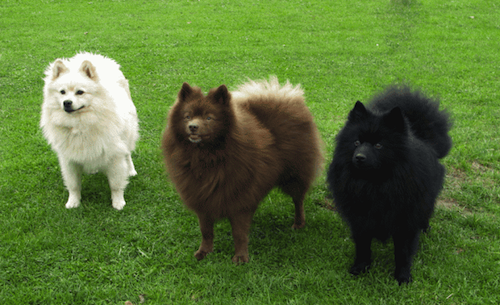
A luxurious coat made to stand off by plentiful undercoat and a spectacular “ruff” around the neck makes the German Spitz a breathtakingly beautiful dog.
Descendant of stone-age Peat Dogs, the Giant German Spitz is the oldest breed originating in Central Europe. Currently an AKC Foundation Stock Service breed, in German, the Spitz has always been divided according to size and color. The original recognized German Spitz breed includes the modern day Wolfspitz (called the Keeshond in the Netherlands), the Gross (Giant) Spitz, the Mittelspitz (Medium Spitz), th eKleinspitz (Small Spitz), and the smallest German Spitz, the Zwergspitz (Dwarf Spitz), or as we know it, the Pomeranian.
In the UK, the German Spitz is recognized in two sizes, and breeding between sizes is forbidden. However Kleins will occasionally pop up in Mittel litters and vice versa because of previous interbreeding. That said, the two sizes share the same breed standard divided only by size. Each size of the German Spitz shares traits common to the Spitz family, that of a happy, watchful, alert, and buoyant dog.
While all colors are accepted by most other registries (and they come in a staggering number), the FCI standard is quite specific about it, and many of the colors and markings shown in the UK would be dismissed from the show ring under FCI rules. Furthermore, in Germany, black and brown may only be bred to blacks and brown, white only to white, and other colors only to those other colors.
In the show ring the colors are also split; the blacks and browns are shown together in their own classes, the whites have their own classes and so have the “other colors.’ At the end of the day, there would be a Best of Breed Black/Brown, a Best of Breed White. and a Best of Breed Other Color.
For the Giant German Spitz, or Großspitz/Grossespitz, white, black, brown are acceptable colors (and in black and brown dogs, white spots on the chest, the paws and the tip of the tail are permissible). The color of nails and pads is preferred to be as dark as possible. At one time, the dogs were traded with fishermen who valued them for their watchdog abilities, and in this way, the breed spread to different towns and regions where they began to vary in size and color. Interestingly, certain colors of the Giant German Spitz became associated with particular regions of Germany, such as black dogs in Wurttemberg.
Go here for an interestingly bit of history on the breed.
Image found on Pinterest and happily credited upon receipt of information
